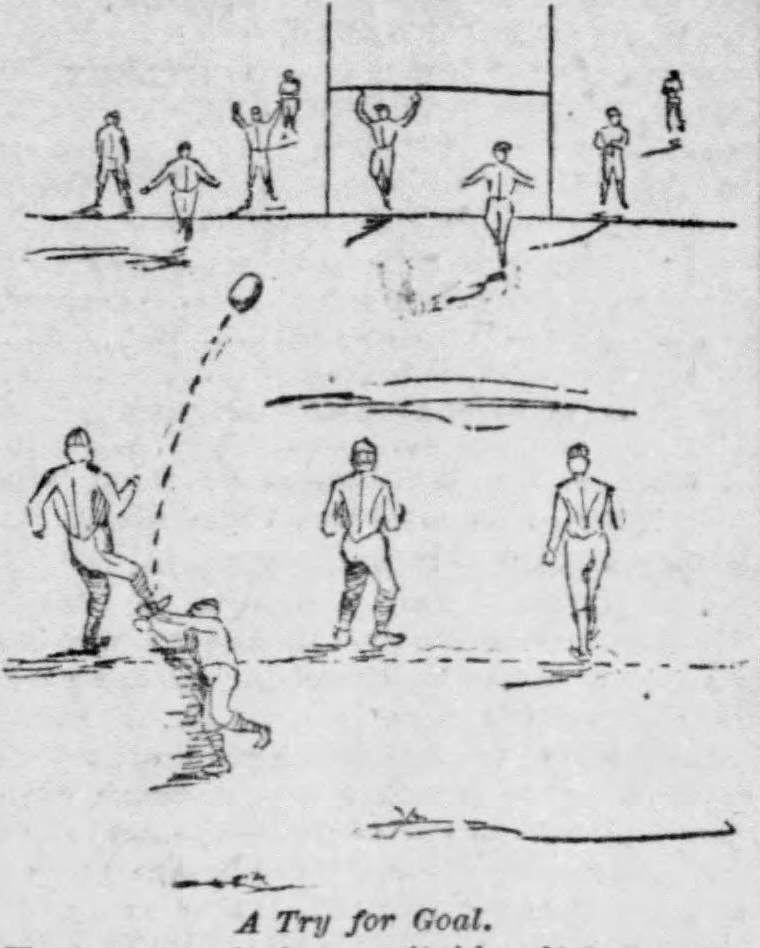Today's Tidbit... 1876 IFA Rule #53: Missed Kicks
This is #53 in a series covering football's original 61 rules adopted by the Intercollegiate Football Association in 1876. We review one rule each Friday.
One of the reasons early football games finished in less than two hours was that the ball was seldom declared dead. There were no incomplete passes, and the ball stayed live when it went out of bounds. One of the few times the ball became dead was when a goal from the field (field goal) or a goal from touchdown (later, the extra point) was successful. The first part of Rule 53 tells us what occurred when a kick was successful.
Rule 53: The ball is dead whenever a goal has been obtained; but if a try at goal be not successful, the kick shall be considered as only an ordinary kick in the course of the game.
The second part of Rule 53 tells us the ball remained live when kicks were unsuccessful. Like today, the ball remained live on missed field goals until the ball went out of bounds, and the defensive team took a touchback or returned the missed kick. If the defense returned a missed kick, the ball was live until the play ended when the ball carrier was tackled, went out of bounds, or scored.
The kicks following touchdowns were a different animal. On those, the clock stopped following the touchdown but restarted upon the miss since the ball was live.
As Stagg recounts in Touchdown (1927), by the late 1880s, teams realized they could deliberately miss the goal after touchdown and attempt to recover the ball for another touchdown or deep in their opponent's territory. More often, the opponent recovered the ball deep in their territory and had to start their possession from an unfavorable position.
That situation changed in 1892 when a missed try after touchdown resulted in a dead ball, with the defenders of the goal getting the ball at midfield. Later, the rule changed, so the team missing the try had to kick from midfield.
Click the appropriate link for previous stories in the series:
Intro | #1 Drop Kick | #2 Place Kick | #3 Punt | #4 Goal Posts | #5 Goal | #6 Goal ≠ Punt | #7 Scoring | #8 Dead Ball | #9 Touchdown | #10 Tackle | #11 Scrimmage | #12 Ball Handling | #13 Dead Ball | #14 Scrimmage Ball Handling | #15 Run In | #16 Goal Line | #17 Boundary Lines | #18 Crying “Down” | #19 Maul In | #20 Maul in Pax | #21 Touch-in Goal | #22 Onside | #23 Offside | #24 Return to Onside | #25 Defensive Offside | #26 Throwing Back | #27 Knocking On | #28 Fair Catch | #29 Punt-out | #30 Punt-On | #31 Into Touch | #32 Inbounding | #33 Pushed Into Touch | #34 Right Angle Throw Out | #35 No Fair Catch | #36 Kickoff | #37 Kickoff Timing | #38 Change Goals | #39 Toss Up | #40 Loser Kicks | #41 Kickout | #42 Kickout Procedure | #43 Fair Catch Free Kick | #44 Free Kick Location | #45 Own Goal Touch Down | #46 Try At Goal | #47 Try At Goal Spot | #48 Touched Down Between Posts | #49 Puntout Spot | #50 Heel-In Mark | #51 No Fair Catch OOB | #52 TD Interference
Football Archaeology is reader-supported. Click here to buy one of my books or otherwise support the site.



I’m researching the try in HS football - so this article is spot on!